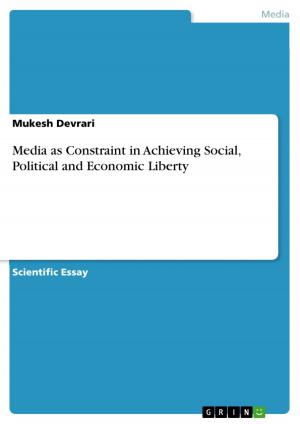Love in William Shakespeare's 'As You Like It'
Fiction & Literature, Literary Theory & Criticism, British| Author: | Julie Dillenkofer | ISBN: | 9783668034846 |
| Publisher: | GRIN Verlag | Publication: | August 24, 2015 |
| Imprint: | GRIN Verlag | Language: | English |
| Author: | Julie Dillenkofer |
| ISBN: | 9783668034846 |
| Publisher: | GRIN Verlag |
| Publication: | August 24, 2015 |
| Imprint: | GRIN Verlag |
| Language: | English |
Seminar paper from the year 2015 in the subject English - Literature, Works, grade: 1,7, University of Heidelberg (Anglistisches Seminar), course: Literature & Film - Adapting Shakespeare for the Screen, language: English, abstract: William Shakespeare's 'As You Like It' portrays love and marriage in a comical, amusing manner. The play represents passionate love on the one hand, as well as disguised, blind and even manipulated love on the other hand. Love as a state of being is omnipresent throughout As You Like It. As the play's major theme, love is illustrated essentially by eight characters who all marry at the end of the play. However, As You Like It cannot be interpreted as a typical love story. In fact, only one twosome, namely Rosalind and Orlando, illustrates a relationship of true love which ends in a happy, mutually agreeable marriage. By falling in love at first sight, they symbolize the typical Shakespearean romantic lovers whose love overcomes any obstacles. The other couples in the play, however, seem to pursue rather different goals. Audrey and Touchstone simply wish to act on their sexual desire, which they cleverly hide behind marriage in order to prevent any 'Vorwurf der Unzucht' - a serious matter in Elizabethan times. Phoebe and Silvius are both in love, though not reciprocally. Silvius does love Phoebe; she, however, falls in love with Ganymede and is merely tricked into committing herself to Silvius. Celia and Oliver are simply following the lead of Rosalind and Orlando, but seem to strive for companionship rather than passion or true love. Shakespeare illustrates four different kinds of love in As You Like It in a humorous way. He demonstrates that love and marriage do not necessarily have to go hand in hand and adds comical aspects of love by turning some characters into fools. In this way, Shakespeare builds on the Elizabethan assumptions about love as a sickness, but still validates it as a valuable aspect of a happy marriage.
Seminar paper from the year 2015 in the subject English - Literature, Works, grade: 1,7, University of Heidelberg (Anglistisches Seminar), course: Literature & Film - Adapting Shakespeare for the Screen, language: English, abstract: William Shakespeare's 'As You Like It' portrays love and marriage in a comical, amusing manner. The play represents passionate love on the one hand, as well as disguised, blind and even manipulated love on the other hand. Love as a state of being is omnipresent throughout As You Like It. As the play's major theme, love is illustrated essentially by eight characters who all marry at the end of the play. However, As You Like It cannot be interpreted as a typical love story. In fact, only one twosome, namely Rosalind and Orlando, illustrates a relationship of true love which ends in a happy, mutually agreeable marriage. By falling in love at first sight, they symbolize the typical Shakespearean romantic lovers whose love overcomes any obstacles. The other couples in the play, however, seem to pursue rather different goals. Audrey and Touchstone simply wish to act on their sexual desire, which they cleverly hide behind marriage in order to prevent any 'Vorwurf der Unzucht' - a serious matter in Elizabethan times. Phoebe and Silvius are both in love, though not reciprocally. Silvius does love Phoebe; she, however, falls in love with Ganymede and is merely tricked into committing herself to Silvius. Celia and Oliver are simply following the lead of Rosalind and Orlando, but seem to strive for companionship rather than passion or true love. Shakespeare illustrates four different kinds of love in As You Like It in a humorous way. He demonstrates that love and marriage do not necessarily have to go hand in hand and adds comical aspects of love by turning some characters into fools. In this way, Shakespeare builds on the Elizabethan assumptions about love as a sickness, but still validates it as a valuable aspect of a happy marriage.















